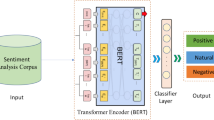Abstract
Machine learning approaches in sentiment analysis principally rely on the abundance of resources. To limit this dependence, we propose a novel method called Siamese Network Architecture for Sentiment Analysis (SNASA) to learn representations of resource-poor languages by jointly training them with resource-rich languages using a siamese network.
SNASA model consists of twin Bi-directional Long Short-Term Memory Recurrent Neural Networks (Bi-LSTM RNN) with shared parameters joined by a contrastive loss function, based on a similarity metric. The model learns the sentence representations of resource-poor and resource-rich language in a common sentiment space by using a similarity metric based on their individual sentiments. The model, hence, projects sentences with similar sentiment closer to each other and the sentences with different sentiment farther from each other. Experiments on large-scale datasets of resource-rich languages - English and Spanish and resource-poor languages - Hindi and Telugu reveal that SNASA outperforms the state-of-the-art sentiment analysis approaches based on distributional semantics, semantic rules, lexicon lists and deep neural network representations without shared parameters.
N. Choudhary and R. Singh—These authors have contributed equally to this work.
Access this chapter
Tax calculation will be finalised at checkout
Purchases are for personal use only
Similar content being viewed by others
Notes
- 1.
The Many Tongues of Twitter - MIT Technology Review.
References
Bahdanau, D., Cho, K., Bengio, Y.: Neural machine translation by jointly learning to align and translate. arXiv preprint arXiv:1409.0473 (2014)
Balamurali, A., Joshi, A., Bhattacharyya, P.: Cross-lingual sentiment analysis for indian languages using linked wordnets. In: Proceedings of COLING 2012: Posters, pp. 73–82 (2012)
Boden, M.: A guide to recurrent neural networks and backpropagation. the Dallas project (2002)
Bromley, J., Guyon, I., LeCun, Y., Säckinger, E., Shah, R.: Signature verification using a" siamese" time delay neural network. In: Advances in Neural Information Processing Systems, pp. 737–744 (1994)
Chopra, S., Hadsell, R., LeCun, Y.: Learning a similarity metric discriminatively, with application to face verification. In: Computer Vision and Pattern Recognition, 2005. CVPR 2005. IEEE Computer Society Conference on. vol. 1, pp. 539–546. IEEE (2005)
Chung, J., Gulcehre, C., Cho, K., Bengio, Y.: Empirical evaluation of gated recurrent neural networks on sequence modeling. arXiv preprint arXiv:1412.3555 (2014)
Das, A., Yenala, H., Chinnakotla, M., Shrivastava, M.: Together we stand: Siamese networks for similar question retrieval. In: Proceedings of the 54th Annual Meeting of the Association for Computational Linguistics (Volume 1: Long Papers). vol. 1, pp. 378–387 (2016)
Dhingra, B., Zhou, Z., Fitzpatrick, D., Muehl, M., Cohen, W.W.: Tweet2vec: Character-based distributed representations for social media. arXiv preprint arXiv:1605.03481 (2016)
Dyer, C., Ballesteros, M., Ling, W., Matthews, A., Smith, N.A.: Transition-based dependency parsing with stack long short-term memory. arXiv preprint arXiv:1505.08075 (2015)
Gao, Y., Rong, W., Shen, Y., Xiong, Z.: Convolutional neural network based sentiment analysis using adaboost combination. In: Neural Networks (IJCNN), 2016 International Joint Conference on, pp. 1333–1338. IEEE (2016)
Joshi, A., Balamurali, A., Bhattacharyya, P.: A fall-back strategy for sentiment analysis in hindi: a case study. In: Proceedings of the 8th ICON (2010)
Kim, Y.: Convolutional neural networks for sentence classification. arXiv preprint arXiv:1408.5882 (2014)
Lample, G., Ballesteros, M., Subramanian, S., Kawakami, K., Dyer, C.: Neural architectures for named entity recognition. arXiv preprint arXiv:1603.01360 (2016)
LeCun, Y., Huang, F.J.: Loss functions for discriminative training of energy-based models. In: AIStats (2005)
Mikolov, T., Sutskever, I., Chen, K., Corrado, G.S., Dean, J.: Distributed representations of words and phrases and their compositionality. In: Advances in neural information processing systems, pp. 3111–3119 (2013)
Mogadala, A., Varma, V.: Retrieval approach to extract opinions about people from resource scarce language news articles. In: Proceedings of the First International Workshop on Issues of Sentiment Discovery and Opinion Mining, p. 4. ACM (2012)
Mozetič, I., Grčar, M., Smailović, J.: Multilingual twitter sentiment classification: the role of human annotators. PloS one 11(5), e0155036 (2016)
Mukku, S.S., Choudhary, N., Mamidi, R.: Enhanced sentiment classification of telugu text using ml techniques. In: SAAIP@ IJCAI, pp. 29–34 (2016)
Mukku, S.S., Oota, S.R., Mamidi, R.: Tag me a label with multi-arm: active learning for Telugu sentiment analysis. In: Bellatreche, L., Chakravarthy, S. (eds.) DaWaK 2017. LNCS, vol. 10440, pp. 355–367. Springer, Cham (2017). https://doi.org/10.1007/978-3-319-64283-3_26
Pang, B., Lee, L.: Seeing stars: Exploiting class relationships for sentiment categorization with respect to rating scales. In: Proceedings of the 43rd annual meeting on association for computational linguistics, pp. 115–124. Association for Computational Linguistics (2005)
Sarkar, K., Chakraborty, S.: A sentiment analysis system for Indian language tweets. In: Prasath, R., Vuppala, A.K., Kathirvalavakumar, T. (eds.) MIKE 2015. LNCS (LNAI), vol. 9468, pp. 694–702. Springer, Cham (2015). https://doi.org/10.1007/978-3-319-26832-3_66
Socher, R., Huval, B., Manning, C.D., Ng, A.Y.: Semantic compositionality through recursive matrix-vector spaces. In: Proceedings of the 2012 joint conference on empirical methods in natural language processing and computational natural language learning, pp. 1201–1211. Association for Computational Linguistics (2012)
Taboada, M., Brooke, J., Tofiloski, M., Voll, K., Stede, M.: Lexicon-based methods for sentiment analysis. Comput. Linguist. 37(2), 267–307 (2011)
Vinyals, O., Kaiser, Ł., Koo, T., Petrov, S., Sutskever, I., Hinton, G.: Grammar as a foreign language. In: Advances in Neural Information Processing Systems, pp. 2773–2781 (2015)
Wang, P., Qian, Y., Soong, F.K., He, L., Zhao, H.: Learning distributed word representations for bidirectional lstm recurrent neural network. In: HLT-NAACL, pp. 527–533 (2016)
Author information
Authors and Affiliations
Corresponding author
Editor information
Editors and Affiliations
Rights and permissions
Copyright information
© 2023 Springer Nature Switzerland AG
About this paper
Cite this paper
Choudhary, N., Singh, R., Bindlish, I., Shrivastava, M. (2023). Emotions Are Universal: Learning Sentiment Based Representations of Resource-Poor Languages Using Siamese Networks. In: Gelbukh, A. (eds) Computational Linguistics and Intelligent Text Processing. CICLing 2018. Lecture Notes in Computer Science, vol 13397. Springer, Cham. https://doi.org/10.1007/978-3-031-23804-8_10
Download citation
DOI: https://doi.org/10.1007/978-3-031-23804-8_10
Published:
Publisher Name: Springer, Cham
Print ISBN: 978-3-031-23803-1
Online ISBN: 978-3-031-23804-8
eBook Packages: Computer ScienceComputer Science (R0)




